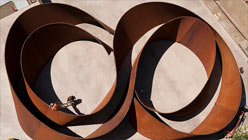Twice a day, on my way to and from work, I walk by a Richard Serra sculpture called Charlie Brown. The 60-foot tall object is located at Gap headquarters in San Francisco, and unless you work in the building, it’s only viewable from The Embarcadero between Folsom and Howard Streets. Composed of four, rusty steel plates, the piece gently twists as it ascends through the building’s east-facing atrium. When viewed from above, the plates apparently overlap at the top to describe a square. From the street, you can sort of get that, but my eye has always been drawn to the opening at the sculpture’s base, an invitation to timidly enter the piece and, one can only imagine, gaze up in wonder.
In late July, 2011, the Bay Area’s newest Serra sculpture, Sequence, from 2006, was installed at the Cantor Arts Center. On loan from the Doris and Don Fisher Collection (Doris and her late husband founded the Gap), it will remain at Stanford until the new Fisher wing at the San Francisco Museum of Modern Art is completed in 2016. Sequence has been living indoors at the Los Angeles County Museum of Art since 2008; this is the first time it’s been exhibited outdoors.
In simple terms, Sequence is basically a parallel pair of figure-eights made of two-inch-thick steel plates that rest on one edge, creating rusty ribbons about 13-feet high. Torqued and angled, the void between the ribbons can be entered from either end, and visitors to the Cantor are invited to stroll the path between the curving bands of steel. Along the way, the walls of the ribbons alternately fall away from or overhang the route, widening and narrowing the path below one’s feet and the slot to the sky above, although usually not at the same time. A pair of somewhat circular, similarly uneven dead-end spaces await at either end.

The first thing you notice when walking through or around Sequence is the shadow of the piece that’s been drawn by the sun. These lines on the sculpture’s concrete foundation are as hard and emphatic as the edges of the steel itself, a precise but naturalistic echo of Serra’s machined creation. Then there’s the steel’s texture, whose rusty splotches give the unforgiving material an improbable softness and warmth.



